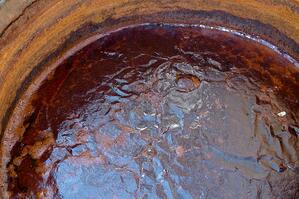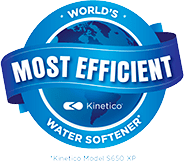There are a number of different water treatment processes you can use to remove unwanted chemicals. Here in Minnesota, one of the most common chemicals we want to get rid of is iron. One way to do that is by using an iron filter. Let’s look at how iron filters work and how that process impacts the quality of our water.
When should you worry about iron?
Iron is the fourth most abundant mineral in the earth’s crust, and it’s extremely common in Minnesota soil and rocks, so it’s not unusual to find iron in Minnesota groundwater. In fact, small concentrations of iron are usually fine, but if there’s too much iron in your water, it can cause all sorts of problems.
Iron can cause red, yellow or brown stains on your clothes, dishes or plumbing fixtures. It can clog wells, pumps, or sprinklers. It can make your water taste like metal, and it can even turn potatoes black.
Iron can present itself in well water in four different forms:
- Ferrous Iron – Water comes out of the faucet clear but turns red or brown after standing, often leaving stains behind. Ferrous iron is invisibly dissolved in the water, so it is often called “clear-water” iron.
- Ferric Iron – Water is red or yellow when first drawn. Ferric Iron is already oxidized (think of rust) and therefore insoluble. That’s why it’s also called “red-water” iron.
- Organic Iron – Iron can form compounds with naturally occurring acids in water. Organic iron is most often red or brown. You may see clumps of iron scum in the water and an oily sheen on the surface.
- Colloidal Iron – This is made up of extremely small particles (smaller than 1 micron). The water may be pink or red, like ferric iron, but the particles are so tiny, they remain suspended in the water.
Ferrous iron is the most common in Minnesota, followed by ferric. Organic and colloidal are much less common and require special treatment. If you suspect organic or colloidal iron in your water, consult a professional for testing and treatment.
How do you remove iron from water?
There are several treatment options that can be used to remove iron in wells and well water. These include:
- Well pasteurization
- Chemical treatments
- Surfactants (soap-like chemicals such as phosphates that enhance chemical treatments)
- Acids
- Disinfectants, particularly chlorine or a “shock” chlorination process
However, iron filters are generally considered the most effective of these options, especially when iron concentrations are high.
An iron filter works much like a water softener
The iron filtration unit contains a “media bed,” like a water softener, but in this case, the media is not resin but an oxidizing agent such as manganese dioxide. When water passes through the bed, the media attracts soluble ferrous iron and converts it to an insoluble state. That allows a filter to capture the iron precipitate, leaving the water iron-free. The system is maintained with periodic backwashing to remove the precipitated iron and, less frequently, regeneration to refresh the oxidizing ability of the media bed.
The best of all worlds
Water softeners can remove soluble or clear-water iron from household water. In fact, water softeners are the most common choice for home and business owners because the unit can remove a host of chemicals beyond iron that make water hard and can cause problems that range from annoying to serious.
On the other hand, if your water has high iron concentrations, it could be that the best solution is a double-whammy. Using iron filters in combination with a water softener can provide maximum improvement in water quality. That’s why it’s wise to have your water tested by a professional, who can take those results and make the best recommendations for your exact situation and water chemistry.









